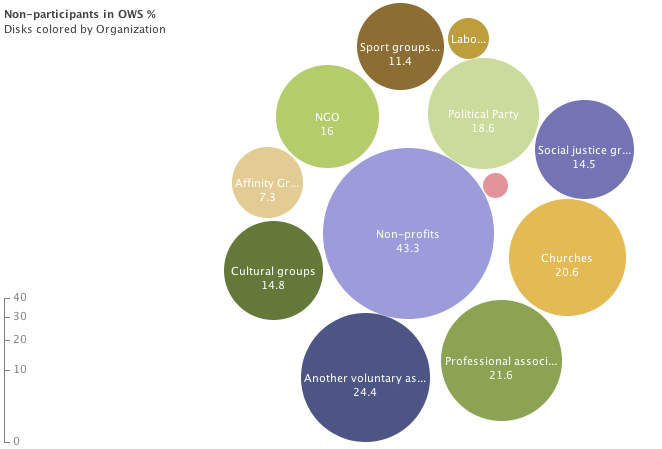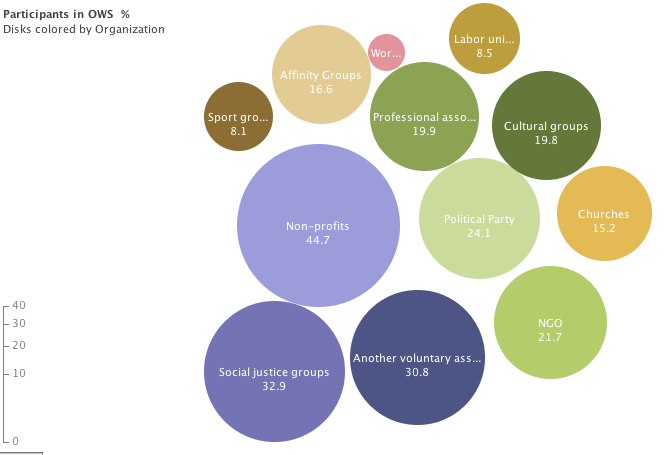According to the Occupy Research General Survey (ORGS), OWS sympathizers and participants are among the most civically engaged individuals of the U.S. population, they possess an active voting record, and tend to be involved in a wide range of organizations and civic actions. The ORGS allows us to explore some of the characteristics of the diverse “civic cultures” of online sympathizers who have brought broad support to OWS in the U.S.
Investigating the civic anatomy of OWS is of critical importance for those who seek to understand the movement’s potential as a force to promote social change through different forms of social and political action, from community-based work and peaceful protest to participatory deliberation and electoral politics. Comparing the different patterns of organizational affiliation (Graph 1) between self-defined participants and non-participants in the movement helps us to think about different civic trajectories, and the diverse pool of mobilizing practices from which Occupiers draw their strategies and political views.
Graph 1. Dimensions of Organizational Affiliation,
OWS Participants vs. Non-participants
The experience in non-profit organizations is clearly central for participants and non-participants. However, the space of the political in Occupy seems significantly shaped by the trajectory of sympathizers in social justice organizations, political parties, labor unions, voluntary associations, affinity and cultural groups (see Table 1). In some cases, affiliation to these institutions is higher among Occupiers than in the overall American population. As aptly argued by professor Wendy Brown, OWS should be understood fundamentally as a civic movement galvanized by the economic crisis, and the reaction to neoliberal policies that have threatened the foundations of democratic governance and public life in America.
Table 1. Organizational affiliation: “I belong and actively participate in…
|
Organizations |
Participants
in OWS |
Non-participants
in OWS |
Sig. | ||
|
n |
% |
n |
% |
||
| Non-profits |
(3193) |
44.7% |
(397) |
43.3% |
|
| Social justice groups |
(3137) |
32.9% |
(387) |
14.5% |
*** |
| Another voluntary associations |
(2994) |
30.8% |
(390) |
24.4% |
* |
| Political Party |
(3231) |
24.1% |
(398) |
18.6% |
*** |
| NGO |
(3056) |
21.7% |
(388) |
16.0% |
|
| Professional associations |
(3095) |
19.9% |
(388) |
21.6% |
|
| Cultural groups |
(3035) |
19.8% |
(385) |
14.8% |
* |
| Affinity Groups |
(3018) |
16.6% |
(383) |
7.3% |
*** |
| Churches |
(3121) |
15.2% |
(388) |
20.6% |
*** |
| Labor unions |
(3149) |
8.5% |
(391) |
2.6% |
*** |
| Sport groups or teams |
(3006) |
8.1% |
(387) |
11.4% |
** |
| Worker center |
(2960) |
2.2% |
(384) |
1.2% |
** |
*** p <0.001, ** p < 0.01, * p < 0.05
Source: ORGS (U.S. residents, n=3,715)
In the electoral front, the voting record of Occupy participants in the ORGS is particularly high when compared to the average voter turnout of the country (64% in the 2008 presidential election). According to ORGS data, 87.5% of Occupiers voted in the 2008 presidential elections, and 80.6% plan to vote next November. These results echo findings of ongoing surveys of visitors to the OWS website.
The obvious conclusion of this evidence is that the popular outrage expressed by the movement is not the result of extremist factions of society but of civic discontent across broad sections of the American public. This is not to say that Occupy is merely an assemblage of political groups and identities. The diversity of civic cultures and trajectories of occupiers should move activists and researchers to critically interrogate the historical roots of the movement, and its emergent identities and structures in connection with existent forms of civic governance in the American society. Answering all these questions may seem an elusive task in the case of a self-defined ‘leaderless’ movement; however, understanding the political and the ‘civics’ in Occupy is critical to assess the future of the movement, and its potential role as a transformative force of American democracy.



Recent Comments